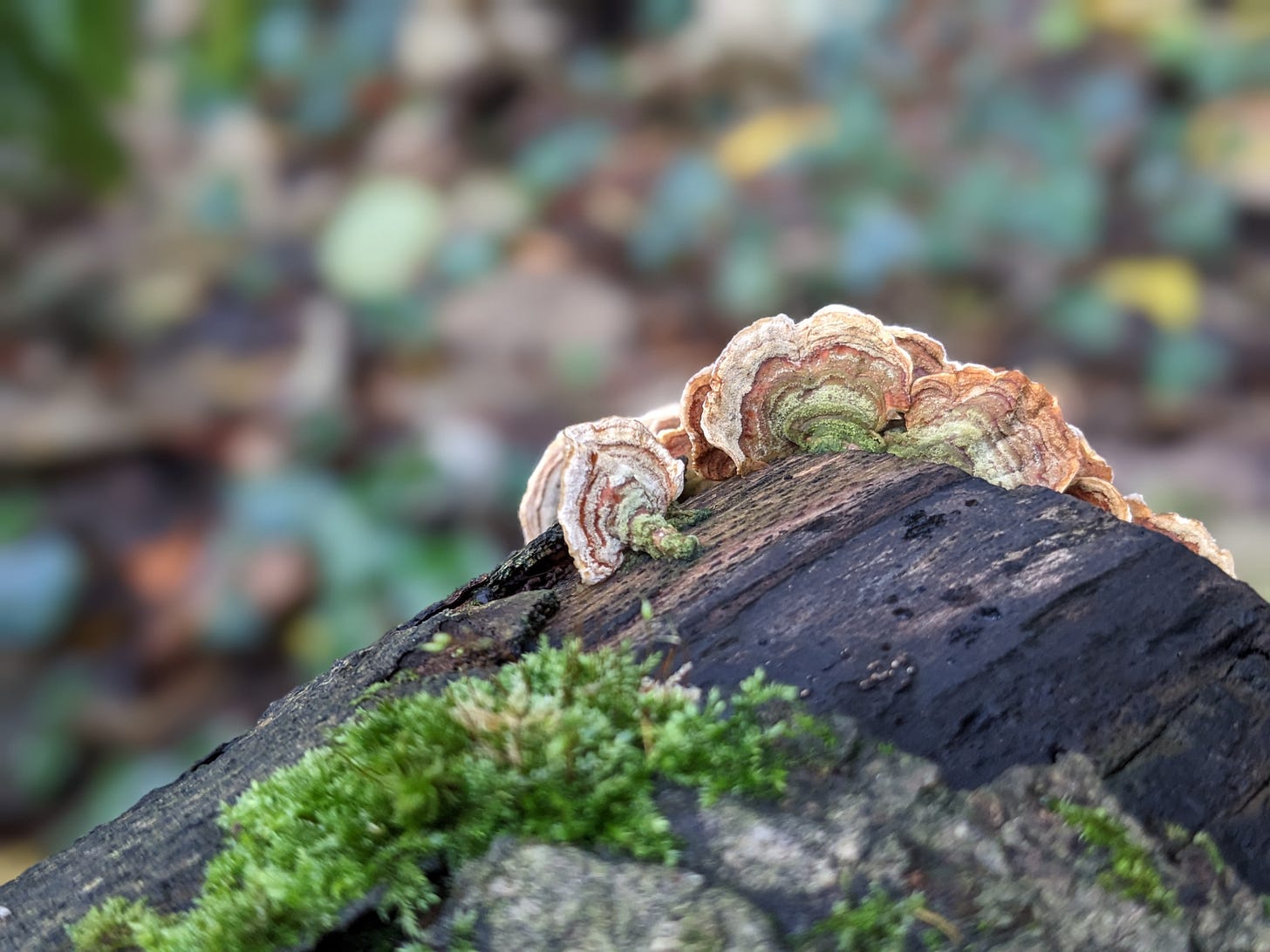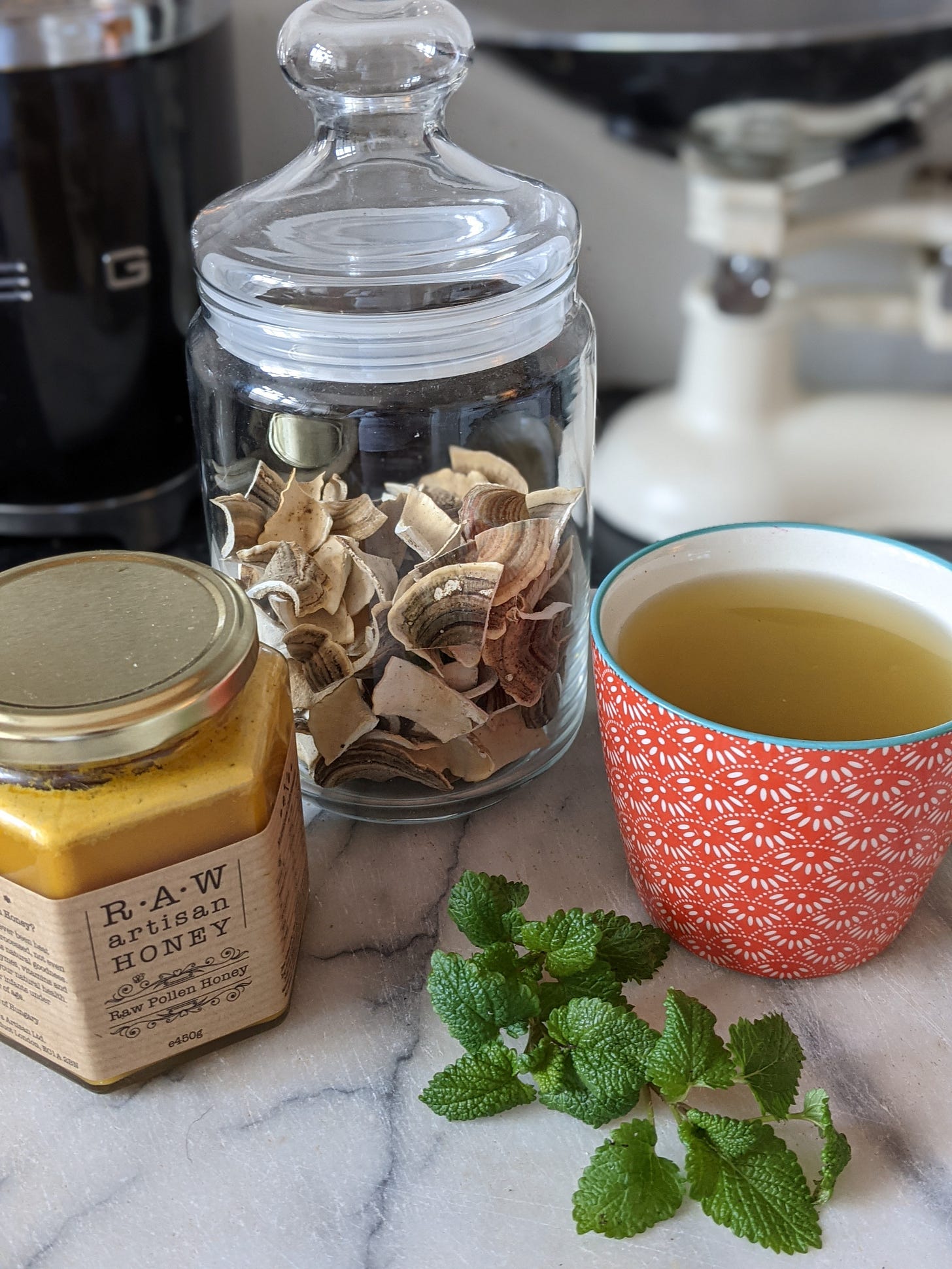A Powerful Boost of Turkey Tail Tea
Activates Qi or vital energy, strengthens lungs, clears away dampness that disprupts organ function and supports the liver
Hi, I’m Sue and I write about the beauty and ingenuity of Nature, and how we can deepen our connection for our optimum health and wellbeing. Discover more Nature-inspired content on Spiral Leaf, Twitter and my video Nature Channel.
Why Turkey Tail?
Turkey Tail is a wild fungus that symbolises longevity and health in many Asian cultures. It has been used for centuries by practitioners of Traditional Chinese Medicine as an immunomodulator that supports repair system function and helps to fight infections.
Turkey Tail supports the health of underactive or overactive repair systems (or immunity), and is unique and long-valued among physicians of traditional medicine.
Turkey Tail is powerfully yet gently medicinal and is used to improve response to cancer medicines and radiation, for building muscle strength, reducing fatigue, increasing vitality and relieving a host of conditions, some of which are mentioned below.
Overall, the nutrients, minerals and trace elements in Turkey Tail fungi are known to balance blood sugar levels, boost athletic performance, fight viral and bacterial infections and reduce fatigue. Some believe it prevents urinary tract infections (UTIs) and protects against age-related cognitive decline.
So, for a general cleanse and boost, a morning dose of Turkey Tail Tea which can be made fresh as per the instructions below or made into a tincture to add to your Cleansing Lemon and Giinger Herbal Tea as an extra complimentary ingredient.
Wild Turkey Tail foraging
Turkey Tail Fungi is easy to identify on the branches and trunks of ancient decaying trees. It has a beautiful pattern resembling turkey tails or oyster shells.
They are gathered in late Winter in the British Isles before it gets too cold and they start to dry out. At this point they can start to lose their whiteness, softness and plumpness, so it’s good to try and find them early on in the mushroom season.
Always leave plenty of Turkey Tails to ensure continuation of the crop and cut them away from the branch gently with a sharp knife as they are quite rubbery and hard to detach by pulling or trying to tear off in small pieces.
Wild Turkey Tail hangouts
Known as Coriolus and Polyporus Vversicolors, Turkey Tail is a multi-coloured polypore fungus that disolves and absorbes dead and decaying wood.
This means it contains a rich source of health boosting minerals, healthy microbes, organic compounds and trace elements that help to clear out unwanted toxins, protect our DNA and strengthen our repair system (or immunity).
You can find Turkey Tail in ancient woodlands, on decaying trees, old shrubs, tree trunks and tree stumps. It's easy to spot and there are no poisonous variations. It can be hard to find even though it grows all over the world. Watch this video - How to Identify Turkey Tail - to help you clearly identify the right variety.
Foraging for Turkey Tail
Locating and foraging for Turkey Tail requires plenty of research to find out where conditions are most favourable and how likely you are to find good specimens, especially those that are larger and more well established.
I have been lucky to find Turkey Tail precisely as needed. My first batch being incredibly plump, white, soft and sensational as pictured in the main photograph heading up this post.
Other finds (above) have been less abundant but very helpful all the same, enabling me to make at least a few powerful brews that last for several weeks.
Washing and drying Turkey Tail
It’s simple to do when you have cut the mushroom carefully from it’s birth to preserve as much of each piece as you can to take home with you.
I then cut away any soil or moss that was still attached and soaked in warm water with some salt to gently remove anything that might be lodged anyway.
Then cut into pieces and lay out on a tray lined with kitchen towel and place in a sunny place, warm aga or airing cupboard to dry slowly and naturally over a few days.
Pop your pieces into a storage jar and take out a small handful to gently simmer see below) for a single brew.
Turkey Tail Tea Ingredients
1 x handful of fresh dried Turkey Tail (3-4 grams dried)
1 x small saucepan of clean filtered water
1 x large spoon Organic Raw Honey
1 x tbs fresh Lemon Juice (optional)
NOTES
Increase quantities proportionately to make larger brews to store in the fridge for daily servings.
When buying dried Turkey Tail, make sure it comes from a reputable provider.
Making a cup of Turkey Tail Tea
1) Add the Turkey Tail to a small or medium pan of filterered water.
2) Gently bring to the boil and simmer for 15-20 minutes.
3) Pour through a fine-grade sieve into a cup, mug or container (if you are storing a larger quantity in the fridge)
4) Serve hot or warm with raw honey and fresh lemon juice.
Going on a course of Turkey Tail Tea
Turkey Tail Tea can be used as an immunity boost on cold days and can be taken as a remedy.
Drink a cup every morning over the course of 12 weeks to completely clear toxins from the body and work it's magic on your repair system and other bodily conditions.
Health & Healing Benefits
Real Mushrooms state that traditional medicine practitioners, particularly those in Asia, have used turkey tail for millennia and that it provides health and long life benefits if consumed regularly.
Key nutrients include:
According to Hybrid Herbs, Turkey Tail contains a wealth of vitamins and minerals including 18 amino acids, beta-glucans, pantothenic acid, triterpenoids, glycoproteins, riboflavin and monosaccharides.
Its mycelium contains polysaccharide peptides and a rare natural compound called polysaccharide-K (PSK). PSK has been studied both vitro and in vitro for over 40 years, and it has displayed powerful anti-tumor properties.
Key benefits include:
Adaptogenic properties - helping the body adapt to stressors - physical, biological, or chemical
Support for repair system - potent immunostimulatory effects to enhance innate and adaptive immune responses
Healthy inflammation response - help to protect the brain as it ages
Protects DNA from damage - removal of free radicals that can be harmful to DNA
Supports gut health - beta-glucans contribute to the health and composition of the gut microbiome
Supports liver health - powerful antioxidant activities support liver health
Improves athletic performance - lowers blood lactate and ammonia after exercise, delays onset of fatigue
Balances blood sugar - lowers blood sugar by escorting it out of the blood and to the cells where glucagon raises blood sugar by prompting the liver to convert stored glycogen into glucose
Key benefits for pets
It’s no surprise that medicinal mushrooms can be helpful for pets although these will differ from the ones that benefit us. They respond to different extracts (not the same as for humans) which can specifically benefit our canine or feline companions. You can find out more here.
Don’t forget the honey
Raw Honey is naturally collected honey hasn't been pasteurised (heated to high temperature), processed or micro-filtered (filtered under high pressure through a micro-filter to remove small particles like pollen).
Raw honey provides a minute amount of protein with trace elements of sodium and potassium, calcium, magnesium, phosphorus, selenium, copper,zinc iron, manganese, chromium, B vitamins and vitamin C and K.
Or the fresh lemon juice
Lemon water (or herbal tea) is the best way to hydrate, purify and revitalise your body every morning before eating or drinking anything else. It reverses sluggish fatty livers, cleans the kidneys, spleen, thyroid and gallbladder. It also purifies the lymphatic system.
That’s it for today, a favourite medicinal tea of mine that I hope will be of benefit.
Have a lovely day and I look forward to sharing more healthy recipes with you again soon.
Further recipes, books and reads
Cleansing Lemon & Ginger Herbal Tea by Sue Cartwright
Citrus Metal Detox Remedy by Sue Cartwright
Going Organic is A Journey by Sue Cartwright
Cleanse to Heal by Anthony Williams, Medical Medium















Great article!. Fungi is the unknown kingdom. We have named 1500 of them classified 800 give or take, one of the worlds leading mycologist at university Wisconsin Madison told me there’s at least 40,000 species on earth.
Paul Stamets is having amazing results with anti-tumor infusions of turkey tail. Check him out at fungi perfecti.
Thank you!